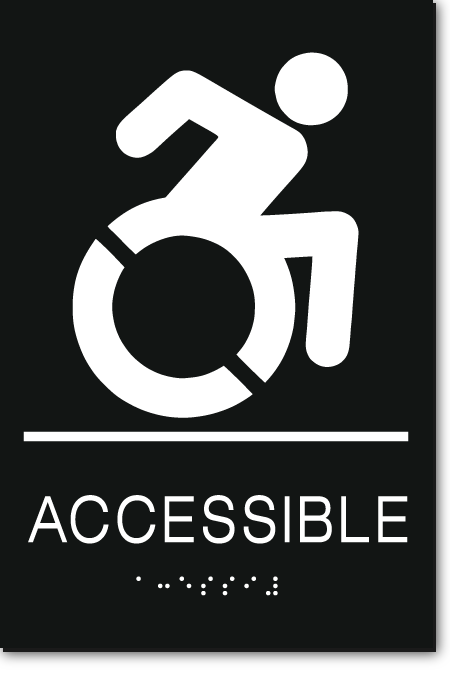ADA Signs: Vital Tools for Inclusive Atmospheres
ADA Signs: Vital Tools for Inclusive Atmospheres
Blog Article
Exploring the Key Attributes of ADA Signs for Enhanced Accessibility
In the realm of access, ADA indications offer as quiet yet effective allies, guaranteeing that spaces are accessible and inclusive for people with specials needs. By incorporating Braille and responsive aspects, these signs break obstacles for the visually impaired, while high-contrast shade systems and understandable font styles provide to varied visual requirements.
Significance of ADA Conformity
Guaranteeing conformity with the Americans with Disabilities Act (ADA) is crucial for promoting inclusivity and equal access in public areas and offices. The ADA, established in 1990, mandates that all public facilities, companies, and transportation services fit people with handicaps, ensuring they appreciate the same legal rights and chances as others. Conformity with ADA requirements not just fulfills legal obligations however likewise improves an organization's online reputation by demonstrating its dedication to diversity and inclusivity.
Among the vital aspects of ADA conformity is the implementation of available signage. ADA indications are created to make certain that people with disabilities can quickly navigate with buildings and spaces. These indications need to follow certain guidelines regarding size, typeface, shade comparison, and positioning to assure presence and readability for all. Effectively applied ADA signs assists get rid of barriers that people with disabilities often run into, thereby advertising their self-reliance and confidence (ADA Signs).
Additionally, sticking to ADA guidelines can minimize the risk of lawful repercussions and prospective fines. Organizations that fail to abide with ADA guidelines might encounter fines or claims, which can be both damaging and financially difficult to their public picture. Hence, ADA conformity is indispensable to fostering an equitable atmosphere for everybody.
Braille and Tactile Elements
The unification of Braille and tactile components into ADA signage embodies the principles of ease of access and inclusivity. It is typically positioned under the corresponding message on signs to make sure that people can access the info without aesthetic help.
Tactile elements extend past Braille and consist of increased signs and characters. These components are designed to be noticeable by touch, enabling individuals to recognize room numbers, restrooms, leaves, and various other essential areas. The ADA sets certain standards relating to the size, spacing, and placement of these responsive components to maximize readability and make sure consistency across different environments.

High-Contrast Color Pattern
High-contrast color design play an essential role in boosting the exposure and readability of ADA signage for people with visual problems. These plans are important as they optimize the distinction in light reflectance in between text and background, making sure that signs are easily noticeable, also from a range. The Americans with Disabilities Act (ADA) mandates making use of details shade contrasts to suit those with restricted vision, making it an important element of compliance.
The efficiency of high-contrast shades depends on useful site their capability to stand apart in various lights problems, consisting of dimly lit atmospheres and areas with glow. Usually, dark text on a light background or light message on a dark background is employed to accomplish optimal contrast. For circumstances, black text on a yellow or white background provides a raw visual difference that aids in fast recognition and understanding.

Legible Fonts and Text Size
When taking into consideration the layout of ADA signs, the selection of understandable typefaces and proper text size can not be overstated. The Americans with Disabilities Act (ADA) mandates that fonts must be not italic and sans-serif, oblique, manuscript, extremely ornamental, or of unusual form.
The dimension of the message likewise plays a critical role in accessibility. According to ADA guidelines, the minimal text elevation should be 5/8 inch, and it should increase proportionally with viewing range. This is particularly essential in public spaces where signage demands to be checked out rapidly and accurately. Uniformity in text dimension contributes to a natural aesthetic experience, helping individuals in browsing settings successfully.
Furthermore, spacing in between letters and lines is indispensable to clarity. Adequate spacing avoids characters from appearing crowded, boosting readability. By adhering to these criteria, designers can dramatically enhance accessibility, making sure that signs serves its designated function for all individuals, despite their aesthetic capabilities.
Reliable Placement Approaches
Strategic positioning of ADA signage is necessary for making the most of access and guaranteeing compliance with lawful criteria. ADA standards state that indications must be placed at a height between 48 to 60 inches from the ground to guarantee they are within the line of view for both standing and seated individuals.
In addition, indicators have to be put nearby to the latch side of doors to permit easy identification prior to entrance. This placement aids people find spaces and spaces without blockage. In situations where there is no door, signs need to be positioned on the local nearby wall. Uniformity in indication placement throughout a center improves predictability, decreasing confusion and enhancing overall customer experience.

Final Thought
ADA signs play a crucial role in advertising accessibility by integrating features that resolve the needs of individuals with specials needs. These components jointly foster an inclusive setting, emphasizing the value of ADA compliance in making certain equal accessibility for all.
In the Extra resources realm of ease of access, ADA indications serve as silent yet effective allies, making certain that areas are navigable and comprehensive for individuals with handicaps. The ADA, enacted in 1990, mandates that all public centers, companies, and transport services accommodate people with disabilities, ensuring they appreciate the same civil liberties and chances as others. ADA Signs. ADA indicators are developed to make certain that individuals with specials needs can quickly navigate with structures and rooms. ADA standards stipulate that indicators need to be mounted at an elevation between 48 to 60 inches from the ground to ensure they are within the line of view for both standing and seated individuals.ADA indications play an important role in promoting access by incorporating functions that resolve the requirements of people with impairments
Report this page